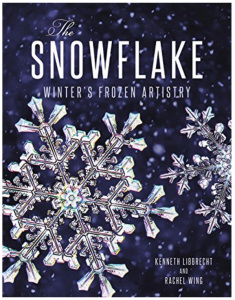|
 By Any Other Name By Any Other Name
An excerpt from The Snowflake: Winter's Frozen Artistry ... Just how many different types of snowflakes are there? We
have examined the more common forms here, but what is the complete
list? In fact, there is no answer to this question. There is no absolute
classification of different snowflake types, and there can never be one.
To understand the dilemma of naming snowflakes, consider a
different question: how many named colors are there? There are the standards,
of course—red, green, blue, yellow, orange, etc.—but is there a complete list
of all color names? No, and there can never be a definitive list.
The names of colors depend on who is doing the naming. The
makers of Crayola crayons, certainly a time-honored authority on the subject,
inventory 133 standard colors, including Jazzberry Jam, Blizzard Blue, Outer
Space, Neon Carrot, and Fuzzy Wuzzy. (We don’t remember any of these from our
crayon boxes growing up, but times have changed.)
The Sherwin-Williams paint company has its own table of over
1500 colors. The whites alone number 184, including Origami White, Feather
White, Alluring White, Frosty White, Superwhite, Nouvelle White, Nebulous
White, Nonchalant White, and Snowfall. You get the picture. While many color
charts are being used for many purposes, there is simply no absolute list of
color names.
You run into similar difficulties when you try to make
definitive lists of all sorts of things—types of breads, cookies, or pastries;
articles of clothing; breeds of dog; types of hobbies; musical instruments;
etc. People do organize and catalog all these items. But different people have
different lists.
We name snowflakes for the same reason we name anything—so
we can more easily talk about them. Certain snow crystals are common and
distinctive looking, and those have fairly well-defined names. Stellar plates,
stellar dendrites, fernlike stellar dendrites, hollow columns, and capped
columns have all been part of the snowflake vocabulary for some time. Go
significantly beyond that, however, and opinions differ.
In an effort to be inclusive, perhaps, tables of snowflake
types have become larger with time. In the 1940s the largest classification
chart included 41 members. This number jumped to 80 in the 1960s, and recently
a new table appeared with 121 different snowflake types.
The chart above shows our preferred snowflake
classification. Since there can be no such thing as a final, definitive
catalog, we pared the number down to one we consider convenient for snowflake
watching. We described many of these snowflake types in the preceding pages,
and the chart gives you an idea of what other kinds of snowflakes you might
encounter.
When you go outside to look at the falling snow, magnifier
in hand, you can use this chart to guide your search for exotic
snowflakes. You are more likely to spot
a triangular crystal, a bullet rosette, or a double plate, if you know it
exists.
|
